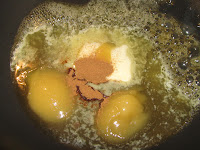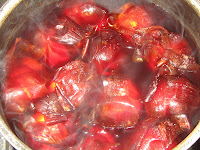The original recipe is prepared with the chards, instead of spinach and the pie is completely covered with the brisèe dough. But I like it the way I suggest.
INGREDIENTS:
Servings: 8
500g spinach or chard (better)
350g ricotta cheese
4+1 eggs
250g Brisèe dough
pinch of salt
1. Sautèe the spinach with some oil and salt.
2. Chop the sauteed spinach into small pieces.

3. Mix the spinach with 100g of ricotta.
4. Mix 250g of ricotta cheese with 1 egg, add a pinch of salt.
5. Dress a mould with the Brisèe dough covering the borders as well. Cut the excess of the dough, we'll need it for decoration.
6. Pour the spinach-ricotta mix into the mould.
7. Make some "holes" in the spinach mix.
8. Pour an egg into a "hole". Repeat with other 3 eggs
9. Cover spinach with ricotta mix.
10. Pull the cut off excess of the dough to create thinner stripes.
11. Place the stripes as a grate, that is crisscross.
12. Turn the borders of the dough inside and pinch them each and every 2 cm.
13. Bake the pie in the preheated oven at 200C for 20-25 minutes till it has a nice golden colour of the crust.
Serve warm or cold as an appetizer or snack.
Note: To make 8 servings, try to find where the eggs are: you will find the 4 bumps. Cut the pie between the eggs into 4 parts and again cut over the eggs to half them.
Happy Easter!!!




































